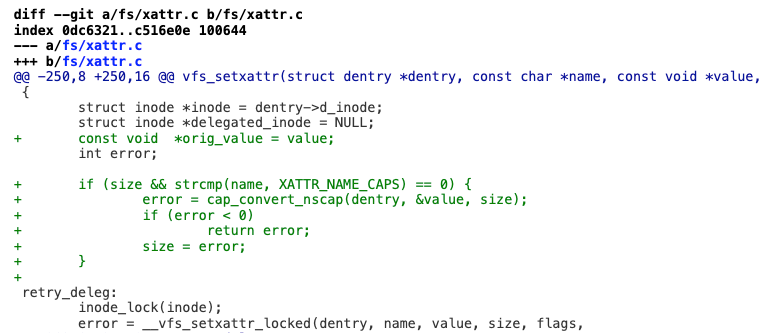CVE-2021-3493漏洞分析
简介
OverlayFS 是一种叠合式文件系统,能够在底层文件系统上叠加另一个文件系统,Linux 内核中 overlayfs 文件系统是 Ubuntu 的特定问题,由于没有正确的验证文件系统功能在用户名称空间中的应用,从而导致攻击者可以安装一个允许未授权挂载的 overlayfs 修补程序来提升权限
漏洞复现
见 Ubuntu内核提权漏洞复现(CVE-2021-3493)
漏洞分析
Overlayfs
Overlayfs是一种类似aufs的一种堆叠文件系统,它依赖并建立在其它的文件系统之上(例如ext4fs和xfs等等),并不直接参与磁盘空间结构的划分,仅仅将原来底层文件系统中不同的目录进行“合并”,然后向用户呈现。因此对于用户来说,它所见到的overlay文件系统根目录下的内容就来自挂载时所指定的不同目录的“合集”。
效果图
Linux Capability机制
Linux内核2.2之后引入了capabilities机制,此前Linux的进程有两类: privileged (effective UID = 0)和unprivileged (effective UID != 0),前者的进程可以绕过所有的内核权限检查,后者则需要进行严格的权限检查。引入capabilities之后,系统会检查effective UID ! = 0进程的capabilities来确认进程是否有执行特权操作的权限。
Linux下可以通过man capabilities来列出capabilities。
User Namespaces
User Namespaces用于隔离用户和用户组,一个用户可以在一个user namespace中是普通用户,但在另一个user namespace中是超级用户。Linux中/proc/PID/uid_map和/proc/PID/gie_map中存储着映射关系,映射关系格式为ID-inside-ns ID-outside-ns length,比如 0 1000 500 表明父user namespace中的1000-1500映射到新user namespace中的0-500。
漏洞原理
一般情况下挂载文件系统需要特权,而在Ubuntu中,普通用户就可以挂载Overlayfs,这源于linux_5.4.0-26-30的更新,在ovl_fs_type结构体中添加了fs_flags数据域,对应值为FS_USERNS_MOUNT
linux_5.4.0-26-30中对ovl_fs_type结构体的修改
这样一来,普通用户也能挂载overlay文件系统,挂载时经过了看不懂的复杂的函数调用链,使得挂载进程的user namespace获得了root权限
而在调用setxattr()函数对文件扩展属性的capability进行设置时,权限校验不彻底,于是可以将文件的capability设置成all+ep,具有高权限。
EXP分析
首先附上完整EXP:
EXP
|
分析
首先看Main函数,该函数fork了子进程并用子进程调用exploit,于是我们跟到exploit函数。
exploit函数分析
漏洞利用的要点是:在使用setxattr()设置capability时,参数上是对./ovlcap/merge/magic设置,而实际上是对./ovlcap/upper/magic进行设置,这里出现了一层由overlay“转发”(merge转发到upper)的操作,正是这一层转发操作跳过了cap_convert_nscap中的权限检查,于是可以将文件设置成all+ep的高权限。这里引用一下大佬的权限逃逸过程:
权限逃逸过程
权限提升后的操作
补丁分析
2021年4月12日的内核补丁对这个漏洞进行了修补,具体实现是每次进入vfs_setxattr函数时,都通过cap_convert_nscap()校验权限,判断capability和user namespace的权限是否匹配,防止出现经过overlay“转发”后权限逃逸的情况。
总结
这是第一次对Linux内核漏洞进行分析,几乎都是看着大佬的文章一步一步跟着走的,也发现了自己的知识面有许多不足,受限于知识水平也无法从内存以及函数调用链分析,只能从表层函数简单地分析原理。
经过这一次的漏洞分析,我对Linux的权限管理,文件系统等方面有了更加深刻的认识,后续有能力了再进行函数调用链以及内存分析…..
参考文章
CVE-2021-3493 Ubuntu内核OverlayFS权限逃逸漏洞分析
深入理解overlayfs(一):初识
创建 user namespace




